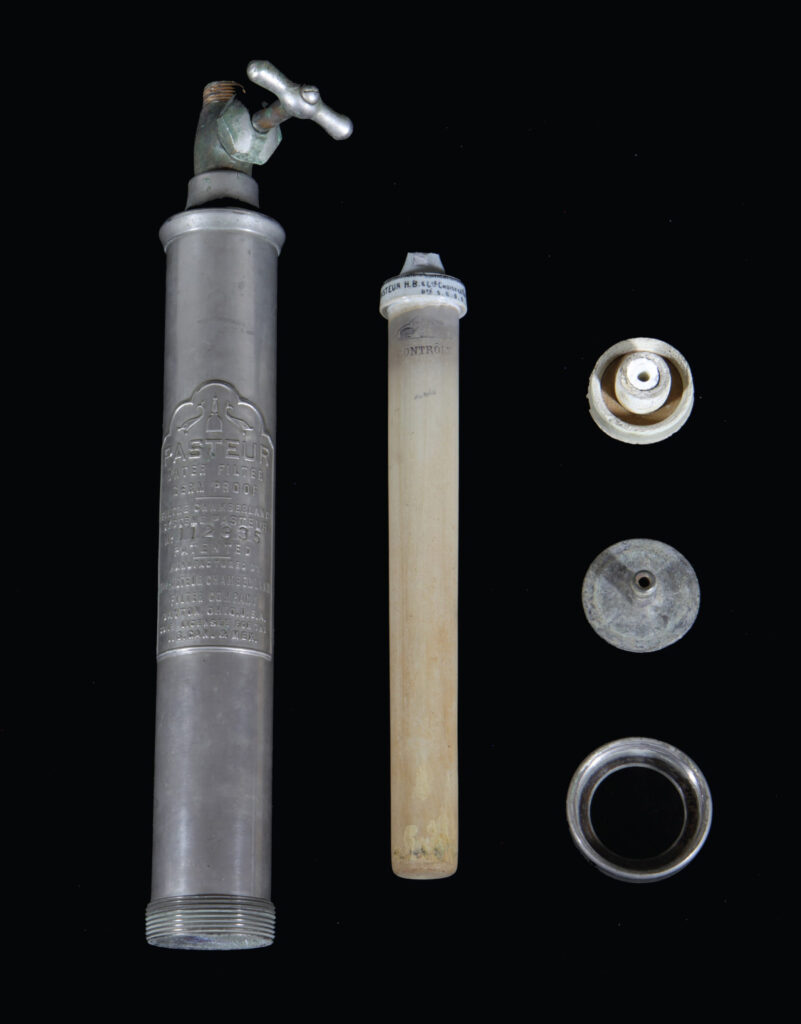If you’ve spent enough time wandering through flea markets or antique shops, you’ve likely walked past, and perhaps even eyed, a large ceramic jug or a thin, shiny cylinder labeled a Pasteur-Chamberland filter. The jugs look like tabletop lemonade dispensers with a spigot on the side. They are expensive—too expensive for me—but I can afford the metal cylinders, which are generally ignored by the antiquing crowd. The metal cylinders were designed with a spigot on the front and fittings on the back to connect to a water pipe. Occasionally the cylinders still contain a fired-clay filter.
I have spent 30 years searching for these tubes, and in that time have found and purchased two with filters still inside. If there were ever an Antiques Roadshow for the history of science, these simple ceramic filters would get top billing: they helped create a new branch of medical knowledge.
People have been filtering water for millennia, sometimes using cloth or charcoal to strain out particulate matter. But before the bacteriological revolution of the 1870s and 1880s, when Joseph Lister, Louis Pasteur, Robert Koch, and others popularized the germ theory of disease, people hadn’t worried about invisible creatures in food and water. Instead, they expected disease to arise from visible, smelly filth that created a poisonous or epidemic atmosphere. No one believed that apparently clean fresh air or water might carry tiny living creatures that could cause disease. Pasteur was among the first to call these circulating germs microbes (for tiny biota), and he showed that these agents, unlike toxins, were alive and could reproduce themselves. The microscopic threats that Pasteur and his colleagues found were primarily single-celled organisms, such as bacteria and yeasts.
Soon after Pasteur made his bacterial work public, many Americans and Europeans turned to Pasteur-Chamberland jugs for protection. What made these filters special? While glazed porcelain is virtually impermeable, unglazed, or bisque, porcelain allows water and other small molecules to pass through. One of Louis Pasteur’s top assistants in Paris, Charles Edouard Chamberland, had invented these filters to produce water that was free of bacteria. But the water being filtered was not originally meant for public consumption; rather, it was made for use in Pasteur’s experiments. Soon, however, news reports of the bacterial causes of tuberculosis, anthrax, cholera, and other diseases drove wider interest in the lab’s filters.

Components of a Pasteur-Chamberland filter from the early 20th century. The porcelain ring (top right) is the broken top of the bisque filter (center).
Chamberland and Pasteur patented the filters, which were produced for commercial sale on both sides of the Atlantic. In the United States a company licensed the name and produced the filters in Ohio, a state rich in clay deposits. The filters quickly found popularity in private homes and in hotels and restaurants. Water served at the 1893 World’s Columbian Exposition in Chicago was filtered to ward off typhoid fever.
And, in fact, the Pasteur-Chamberland filter and others like it saved many lives. But the device’s intellectual contributions to science were much longer lasting. Since bacteria and other single-celled creatures were the smallest known living organisms, scientists were surprised that liquids passing through the filter still sometimes caused illness. Further experiments revealed that for certain disease-producing microbes the filtered liquid, or filtrate, always retained the ability to cause disease. The discovery of diphtheria and tetanus toxins in the filtrates quickly led to the production of lifesaving antitoxins for these deadly diseases in the 1890s.
In other cases there was a far more striking anomaly: the filtrate not only caused harm when injected into animals but also harbored infectious material that, unlike a toxin, could replicate itself under the right conditions. This infectious material was regarded as a “filterable virus” (virus was a traditional word for poison or filth) for its ability to pass through the finest of the Pasteur-Chamberland filters. To everyone’s surprise scientists soon found evidence that these viruses were alive: they could multiply inside living cells and so must be living entities, even if they were far, far smaller than bacteria and other single-celled creatures.
As scientists focused in on these new entities, the how of their discovery lost importance and “filterable” was dropped from their name. But from these humble filters a new field was born—virology—and a new branch was added to the tree of life.
What became of the Pasteur-Chamberland filters? After about 1900, more and more cities built industrial-scale filtration plants to clean up their drinking water. In time they added chlorine to water supplies as well. The infrastructure required was large and expensive, but cities and their residents recognized the need. Health officials enthusiastically recorded the drop in cases of infectious disease. Americans came to take the safety of their water for granted, and they abandoned their handy little filters. Louis Pasteur’s name remains widely known, but his filter and the name of its inventor are both largely forgotten.




